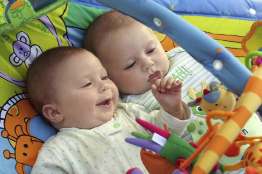Session 3
1. Session 3
1.3. Inquiry 2
Session 3: Language Development
Inquiry 2: Developmental Milestones from Birth to Five Years
The Language Development table provides guidelines to illustrate how children progress through the stages of language development. It is important to remember that each child is unique and develops at his or her own rate.
Principles of Language Development

iStockphoto/Thinkstock
Consider the following principles of language development.
- All children are born with the ability to learn language.
| – As with other development areas, there are wide variations in the age at which children acquire language skills. |
- Children progress through predictable stages of language development.
| – The stages of language development are universal, regardless of which language the child is learning. Babies all over he world go through the same progression and utter the same sounds. |
- Language development is closely related to other developmental areas.
| – For example, when children reach the stage of intellectual development in which they can remember that a toy is put away in a cupboard, they will be able to use language to get the toy (e.g., Hafez points to the cupboard and says, “ball”). |
- Social language is used to express emotions or needs.
| – Children develop social language by imitating how adults and children interact with each other. |
- Children learn language as they play.
| – Children experiment with sounds as they shake toys when they are infants. Infants imitate sounds and gestures. Toddlers add new words and names for objects. Preschoolers experience a massive increase in their vocabulary and grammar, using imaginary situations (e.g., “Let’s pretend that . . .”) as well as real situations. Learning speech and language through play allows children to learn how to express their feelings and become more confident and secure. |
- Listening is a skill that children develop over time.
| – When children are in school, they are expected to listen in order to learn. Babies have difficulty listening to one voice when there are lots of noises around them. Children who, on a regular basis, do not seem to respond to noises, including voices, may have a hearing problem. It may be a good idea to have their hearing checked. |
- Respect the importance of preserving the child’s first language while providing assistance in English.
| – Many children in early childhood programs come from families in which English is not their first language. Language and culture give children a sense of pride in their identity, so it is important to preserve and respect diverse languages and cultures. |
- Children learn about language by interacting with adults.
| – Adults are the role models that children copy when producing sounds or using vocabulary and grammar. Adults provide information and questions. When children use incorrect language or inappropriate language (such as swearing), adults can gently model the correct language. This works best when children and adults have developed a positive relationship with each other and have fun together. |
Adapted from content provided by Grant MacEwan University and Alberta Health Services.
Checking My Understanding
Ideas on Language Development
Directions
In this Ideas on Language Development interactive activity, indicate whether each statement is true or false.
Encouraging Conversations
When children first learn to talk, they generally talk at others rather than with others. Being able to engage in conversation is an extremely important skill in the social world. With help, children learn and will accomplish the following:
- the ability to take turns when talking
- the ability to listen to what the other person is saying and then respond to that person
- increased vocabulary and grammar
Use the following strategies to support children’s learning by engaging them in conversation:
- Imitate the child to give the child the sense of an audience.
- Wait for the child to respond, and then accept what the child says. Next, provide another response so that your “conversation” is maintained.
- Look for ways to take turns during play and talking times. For example, with a toddler, roll a ball back and forth and say, “Your turn, my turn.”
- When a child says a word, repeat the word back to the child and add one or a few more words.
- Demonstrate what you mean with actions or in play. For example, rolling a ball back and forth lets the child explore the motion of taking turns.
- Expand conversations children have with you by asking simple questions or adding your thoughts or opinions in short phrases.
- Talk about things that interest the child.
- Avoid asking test questions—questions that make a child feel like she or he is being “put on the spot.” Test questions are not part of a true conversation.
- Avoid asking questions that require “yes” or “no” responses, as these questions do not demonstrate the give and take of conversation. Ask open-ended questions instead.
Adapted from content provided by Grant MacEwan University and Alberta Health Services.
test question: a question asked for which the answer is already known
Important: Remember that children will be listening and copying how you talk with other adults!